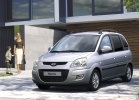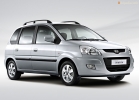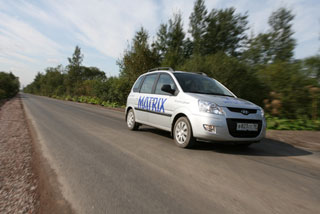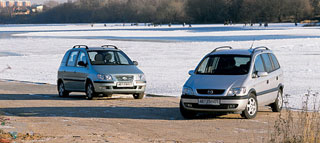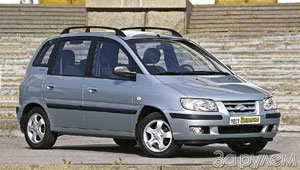Hyundai Matrix test drive since 2001 minivan
Mini for midi
The minivans captured not only part of the market and wallets of Europeans as well. Hyundai Motors, not wanting to lag behind competitors, in 2001 put the FC model to the market, and in this Matrix.Matrix was created on the basis of a rather famous Lantra class model in Russia (aka Elantra, aka Avante). Despite this, as well as the similarity seen by some of the UPV Hyundai Trajet, the minivan looks absolutely in its own way. The fact is that when it was created, it was not without Italians, more specifically, without Pininfarina.
Thanks to the small details, successfully scattered throughout the body, the model is recognizable not only by cutting of the front wing arch and a highly raised rear window, which is located in the cargo compartment, but also by general outlines, especially on the original crossings of the panels on the upper elements of the hood and the back . Minivan stylistics slightly hints that his body was developed by the same office as the body of the famous Fiat Multipla. True, taking into account the national characteristics and complaints about the ruble of the Italian minivan. The restless techies, however, note that such a surge is forced, and turned to it for reasons of the struggle for internal volumes. Be that as it may, the appearance of Matrix in a good sense is peculiar that in the days of the wash and the descendants of the Commission Brutt (the R.W. Model, Hanomag (1924) is nicknamed for the forms of Komissbrot bread) is very on the hand of dealers.
Appearance, but you will not go far on it. And the running qualities of Matrix are very contradictory. First of all, due to a pendant designed for good roads. A car that has a high center of gravity (and here it is just like that) at high speeds, willy-nilly should hardly roll in corners. To avoid this, the developers of Matrix tried to find a compromise: the suspension was made quite stiff and short -handed.
For German and others, autobahns with them, this option is most likely the only correct one. However, we, in Russian megacities, the behavior of the pendant of the Korean minivan can cause, to put it mildly, bewilderment. And this is why: either a short course of the suspension mechanism, or its rigidity provoke the appearance of loud knocks when moving through potholes in the asphalt. At a speed of about 40 km/h, this is not very manifested, but when reaching 60 70, it is worth carefully around the hatches and other charms of city roads in order to avoid unwanted music, which presses on the ears in the voluminous salon with closed windows.
Otherwise, the Matrix suspension deserves the most worthy reviews, taking into account the car class, of course. Despite the high center of gravity, when maneuvering at high speeds (80 120 km/h), the minivan body is not very fucked, and the inhabitants of the salon do not experience discomfort.
Speaking of discomfort. Some of the German journalists noted that landing in this car is not very convenient. For a long time we could not understand: it seems that everything is in place, the seats are decent, the legs for the legs are more than enough, for heads and shoulders all the more so that colleagues from Germany did not suit? They came to the conclusion that the Germans did not carry out comparison with analogues, who, as usual, sin with a freight landing, but with sedans, who, of course, are more comfortable.
Some Matrix classmates, who came out of the hands of other eastern manufacturers, differ from our minivan in lower seats, creating the illusion of a classic landing in the sedan. Is it good? If you approach from a practical point of view, Matrix seats have just those that and should have a four -meter minivan helping to save a place to accommodate the legs of passengers and baggage.
As for the climate in the cabin, our team of four, which rolled in the city more than 100 km at a sufficiently high ambient temperature (26,28C) and, alas, have not experienced inconvenience standard for a normal working day. A decent air conditioner helped to cope with heat, automatic KP with traffic jams.
In general, a tandem from a machine gun and a 1.6-liter engine very well cope with its duties. Having a little accustomed to the transmission algorithm, you can dynamically move not only in urban conditions, but also along the highway, while spending about 10 liters of gasoline per hundred kilometers. True, at high temperatures of external air, the air conditioner determines the increased (by 3 5 liters per hour) fuel consumption. Provokes voracity and inept handling of air conditioning. And you still do not need to get carried away, standing in the jams, air fence from the outside: internal recirculation is organized completely allows you to fence off from banging/kamazov and saves fuel.
The optimal engine operating mode is 2000 3000 min-1. The car touches quite confidently, gains speed well; At the same time, passengers do not throw back and forth, and gasoline consumption does not go beyond the normative.
The luggage compartment of Matrix was not at first impressed, but in a detailed study of the interior transformation options, it turned out that the possibilities of this minivan are much more extensive than it seems. Firstly, the rear seats without much difficulty, separately, are transformed into a cargo platform. Secondly, they can be moved forward, increasing this very site by almost 15 centimeters. Thirdly, just put it up, making Matrix conditionally cargo-passenger with a useful internal volume of more than 1200 liters (permissible carrying capacity of the minivan of 477 kg).
As for all drawers, boxes, recesses and other things, there are more than enough, even under the rear seat there are cavities.
In our opinion, it makes sense to use this car in the role of a family car, which on weekdays takes the head of the family to the service (with the importation of children to school or kindergarten, for example), and on weekends brings the family in full force on the bosom of nature. Not closed for Matrix and the ways to the category of rebellious cars: it is roomy, economical, convenient and attractive. It’s not a shame on such a fuel guest at the airport to meet not an official, of course, accustomed to the limousines of class S, but a normal hard worker who pays secondary attention.
Matrix today has three main modifications: with gasoline engines 1.6 (103 hp) and 1.8 (122 hp), as well as with a three -cylinder turbodiesel of 82 hp. True, the last option has not yet been supplied to Russia. For active driving, the version with the 1.8 engine is quite talked at high speeds, since it must be less often twisted.
It is curious that the cost of Hyundai Matrix in Russia ($ 15 16 thousand) is slightly different from its value in the same Germany.
Technical characteristics of Hyundai Matrix 1.6 GLS
Body 5-door minivan
Number of places, people. 5
Equipped mass, kg 1323
Full mass, kg 1510
Dimensions (length/width/height), mm 4025/1740/1685
Maximum speed, km/h 170
Acceleration time to 100 km/h, С ~ 12.7
Fuel control (mixed cycle), l/100 km ~ 8.4
Engine:
-type in order, 4-cylinder, 8-valve
- working volume, cm3 1599
- Power, L.S. at MIN-1 107/5800
- torque, NM at min-1 141/4500
- power supply system. injection
Transmission automatic., 4-speed
Tire size 195/55r15
Wheel suspension:
- Front Independent, Mcphereson
- rear unencisha., Multi -link
Brakes with ABS;
- front disk
- The rear drum
Steering gear-rake, with gur
Price, $ 15990
Text: Igor Vladimirov
Source: Magazine 5 wheel [08/2002]



